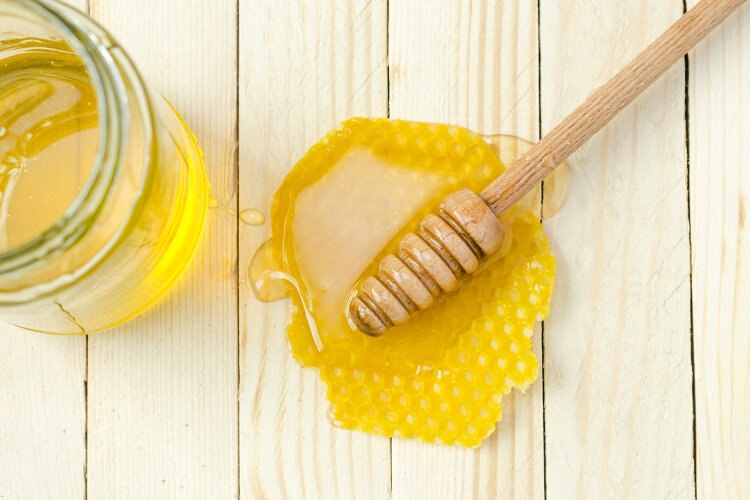The Truth About Honey
Let’s get clear about honey and sugar. There are differences. There are little known facts. There are serious health implications. We commend the research and study of honey by Dr. Ronald Fessenden who is tirelessly working to make plain the seemingly mythical properties of honey. Here is an excerpt from his paper Honey: More than Just a Sweetener, Naturally.
Dr. Fessenden is retired from active medical practice and spends most of his time researching and writing about honey and health. He is the co-chairman for the Committee for the Promotion of Honey and Health in America, an independent non-profit organization devoted to educating the consumer with regard to the healthful benefits of honey and promoting the honey and health message based on good science.
Honey History
For centuries honey has enjoyed a positive image as nature’s sweet substance. Biblical references refer to its sweetness. Culinary schools and chefs consider it an alternative to sugar. Grocery stores and health food outlets stock it on the “sweetener” shelves. To most people, honey is simply a sweetener, in a market flooded with sweeteners and sugar substitutes.
However, to include honey in the category of “sweeteners” risks missing a more significant message. To be sure, honey is sweet. But honey is more than just a sweetener. It is a wonderful, natural, historic food containing secrets that have been hidden or ignored for too long in the United States.
Honey is what the marketing industry refers to as a “functional food,” also known as a nutraceutical—a natural food that delivers a health benefit. The past ten years have witnessed an emergence of a major marketing trend focusing on these foods.
Certain natural foods are beneficial because they contain nutrients not found in processed foods and refined sugars. These nutrients provide numerous benefits, including, to name a few, lowering blood pressure and cholesterol, reducing the risk of cardiovascular disease, fighting cancers, improving the immune system, and controlling blood sugar.
HONEY: A FUNCTIONAL FOOD
Welcome honey to this growing list of functional foods. Thanks to the honeybee, nectars from plant and tree blossoms are converted to a concentrated mixture of fructose (“fruit sugar”) and glucose in an almost equal ratio. (The actual ratio of fructose to glucose concentrations varies depending on the varietal.) Also contained in honey: a small amount of other sugars, amino acids, phyto-nutrients (or plant nutrients), bioflavonoids, antioxidants (at least 16 of them!), small amounts of vitamins, organic acids, and mineral elements, plus a few enzymes added by the bee. When honey is consumed, the best of the nutrients concentrated from plant blossom nectar is available for immediate absorption into the body for food and energy.
This average 1:1 ratio of fructose to glucose found in commonly available honey is the key to one of its most significant health benefits. Fructose derivatives in the liver activate the release of glucokinase from the liver mitochondria. Glucokinase is necessary for the conversion of glucose to glycogen in the liver. In other words, the presence of fructose facilitates or accelerates the conversion of glucose to glycogen. Insulin becomes in effect a fat-storing hormone that rapidly ushers glucose out of the bloodstream and into the cells.
Depending on the immediate energy needs of muscle cells, some of the glucose is converted to glycogen to be used for fuel. Most of the glucose from a typical high-carbohydrate meal Honey is what the marketing industry refers to as a “functional food,” also known as a nutraceutical—a natural food that delivers a health benefit. The past ten years have witnessed an emergence of a major marketing trend focusing on these foods. Certain natural foods are beneficial because they contain nutrients not found in processed foods and refined sugars. These nutrients provide numerous benefits, including, to name a few, lowering blood pressure and cholesterol, reducing the risk of cardiovascular disease, fighting cancers, improving the immune system, and controlling blood sugar. (excluding one with honey) is stored in the cells as fat. With fructose present, as in honey, glucose is stored as glycogen in the liver, where it is available for use by the brain, the heart, the kidneys, and the red blood cells during periods of rest and recovery.
In other words, galactose facilitates the uptake of glucose into the liver and its utilization as an energy source. Infants who lack the enzyme that metabolizes galactose fail to thrive. Adults who over the years consume large quantities of carbohydrates and store large amounts of fat run the risk of failing to thrive, in a metaphoric sense. However, like infants, adults who are provided with the proper “accelerator” in their diet to facilitate glucose-to- glycogen conversion produce adequate stores of liver glycogen and reduce their risk of developing many disease states or conditions associated with metabolic stress.
Fructose consumed by itself (as in foods containing high fructose corn syrup, or HFCS) presents the body with a different set of challenges. Whereas every cell in the body can metabolize glucose, it is the liver that is the primary location for fructose metabolism. Dr. William J. Whelan, a biochemist at the University of Miami School of Medicine, stated it this way: When fructose reaches the liver, “the liver goes bananas and stops everything else to metabolize the fructose.” Studies that have compared HFCS with refined sugar or sucrose find that they have essentially identical physiological effects in the body with regard to elevated blood sugar and insulin levels. Other studies have indicated that fructose consumption over time can lead to insulin resistance, obesity, and elevated LDL cholesterol and triglycerides. (There is disagreement regarding the long-term effects of fructose consumption on the body; observational studies have produced conflicting results. This may be due in part to the relatively short duration of the trials, the lack of dietary control, and the lack of non-fructose–consuming control groups, all of which are confounding factors in human experiments.)
With its ideal combination of fructose and glucose, honey minimizes or avoids many of the results of consuming refined sugar in sugary sweets or HFCS in soft drinks. Honey does not produce the high insulin spike that follows the ingestion of sugar (sucrose) or other simple carbohydrates. The fructose in honey facilitates the uptake of glucose into the liver: glucose is converted to glycogen and stored for later use. Blood sugar swings are modulated, preventing the metabolic stress that typically occurs from insulin spikes following the ingestion of high glucose loads and the subsequent hypoglycemia.
The body’s response to low blood sugar or hypoglycemia (a condition that follows, within an hour and a half to two hours, eating carbohydrates high on the glycemic index) is to release adrenaline and cortisol, “stress hormones” that force the breakdown of muscle protein for conversion to glucose for fuel. Over time, this repeated overdosing on sugar and high fructose corn syrup (both refined sugar and HFCS are “toxic sweeteners” in the dosages currently consumed*), the chronic over-secretion of insulin, the resultant wide swings in blood sugar levels, and the release of adrenaline and cortisol result in what is termed insulin resistance (IR), which leads to impairment of glucose metabolism and type 2 diabetes.
We have pored over the research and decided long ago that choosing honey (organic honey!) is the nutrition-packed superfood our world should consume instead of sugar. All of our Blume Honey Waters are lightly sweetened with a touch of organic honey.
Cheers to health!

